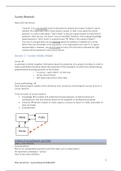Summary
Summary Survey Research
- Course
- Institution
You can message/email me to get the summary for 4 euros. The summary includes all info from the slides/transparencies up until session 8 so far. notes from Pieters, and the thumbs up. Everything will be updated this week.
[Show more]



